Drilling and blasting
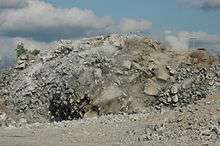
Drilling and Blasting is the controlled use of explosives and other methods such as gas pressure blasting pyrotechnics, to break rock for excavation. It is practiced most often in mining, quarrying and civil engineering such as dam or road construction. The result of rock blasting is often known as a rock cut.
Drilling and Blasting currently utilizes many different varieties of explosives with different compositions and performance properties. Higher velocity explosives are used for relatively hard rock in order to shatter and break the rock, while low velocity explosives are used in soft rocks to generate more gas pressure and a greater heaving effect. For instance, an early 20th-century blasting manual compared the effects of black powder to that of a wedge, and dynamite to that of a hammer.[1] The most commonly used explosives in mining today are ANFO based blends due to lower cost than dynamite.
Before the advent of tunnel boring machines, drilling and blasting was the only economical way of excavating long tunnels through hard rock, where digging is not possible. Even today, the method is still used in the construction of tunnels, such as in the construction of the Lötschberg Base Tunnel. The decision whether to construct a tunnel using a TBM or using a drill and blast method includes a number of factors. Tunnel length is a key issue that needs to be addressed because large TBMs for a rock tunnel have a high capital cost, but because they are usually quicker than a drill and blast tunnel the price per metre of tunnel is lower.[2] This means that shorter tunnels tend to be less economical to construct with a TBM and are therefore usually constructed by drill and blast. Managing ground conditions can also have a significant effect on the choice with different methods suited to different hazards in the ground.
History
The use of explosives in mining goes back to the year 1627,[3] when gunpowder was first used in place of mechanical tools in the Hungarian (now Slovakian) town of Banská Štiavnica. The innovation spread quickly throughout Europe and the Americas.
While drilling and blasting saw limited use in pre-industrial times using gunpowder (such as with the Blue Ridge Tunnel in the United States, built in the 1850s), it was not until more powerful (and safer) explosives, such as dynamite (patented 1867), as well as powered drills were developed, that its potential was fully realised.
Drilling and blasting was successfully used to construct tunnels throughout the world, notably the Fréjus Rail Tunnel, the Gotthard Rail Tunnel, the Simplon Tunnel, the Jungfraubahn and even the longest road tunnel in the world, Lærdalstunnelen, are constructed using this method.
In 1990, 2.1 million tonnes (2.32 million short tons) of commercial explosives were consumed in the United States, representing an estimated expenditure of 3.5 to 4 billion 1993 dollars on blasting. Australia had the highest explosives consumption that year at 500 million tonnes (551 million short tons), with Scandinavian countries another leader in rock blasting (Persson et al. 1994:1).
Procedure

As the name suggests, drilling and blasting works as follows:
- A number of holes are drilled into the rock, which are then filled with explosives.
- Detonating the explosive causes the rock to collapse.
- Rubble is removed and the new tunnel surface is reinforced.
- Repeating these steps until desired excavation is complete.
The positions and depths of the holes (and the amount of explosive each hole receives) are determined by a carefully constructed pattern, which, together with the correct timing of the individual explosions, will guarantee that the tunnel will have an approximately circular cross-section.
During operation, blasting mats may be used to contain the blast, suppress dust and noise, for fly rock prevention and sometimes to direct the blast.[4][5]
Rock support
As a tunnel or excavation progresses the roof and side walls of need to be supported to stop the rock falling into the excavation. The philosophy and methods for rock support vary widely but typical rock support systems can include:
- Rock bolts or rock dowels
- Shotcrete
- Ribs or mining arches and lagging
- Cable bolts
- In-situ concrete
Typically a rock support system would include a number of these support methods, each intended to undertake a specific role in the rock support such as the combination of rock bolting and shotcrete.
Gallery
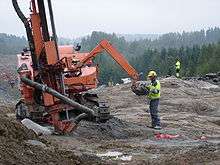 Blast hole drilling with Tamrock Scout 700
Blast hole drilling with Tamrock Scout 700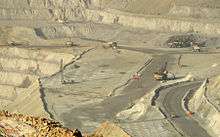 Blast-hole drilling at the Bingham Canyon Mine, Utah. Note the pattern of drill holes being prepared for blasting.
Blast-hole drilling at the Bingham Canyon Mine, Utah. Note the pattern of drill holes being prepared for blasting. Loading blast holes with ANFO
Loading blast holes with ANFO- Rock surface newly blasted. This is called pre-split, it's a technique to leave a smooth face.
 Sideling Hill road cut formed by rock blasting
Sideling Hill road cut formed by rock blasting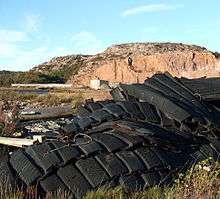 Tire blasting mats for fly rock prevention and dust suppression.
Tire blasting mats for fly rock prevention and dust suppression.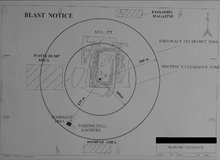 Map describing the clearance zones during blasting in a limestone quarry. These notices are produced by surveyors (see topography).
Map describing the clearance zones during blasting in a limestone quarry. These notices are produced by surveyors (see topography).
See also
References
- Persson, Per-Anders; Roger Holmberg; Jaimin Lee (1994). Rock Blasting and Explosives Engineering. Boca Raton, Fla.: CRC Press. ISBN 0-8493-8978-X.
- Notes
- ↑ Maurice, William (c. 1910). The Shot-Firer's Guide. London: "The Electrician" Printing and Publishing Company Ltd. pp. 79–80.
- ↑ Kolymbas, Dimitrios (2005). Tunelling and tunnel mechanics: a rational approach to tunnelling. Springer-Verlag. p. 444. ISBN 3-540-25196-0.
- ↑ Gary L. Buffington, The Art of Blasting on Construction and Surface Mining Sites, American Society of Safety Engineers (2000).
- ↑ Hansen, T. C., ed. (2004). Recycling of Demolished Concrete and Masonry (Illustrated ed.). Boca Raton, Florida: CRC Press. p. 284. ISBN 0-203-62645-1.
- ↑ "Incidents like Cape Ray blasting mishap deemed rare". www.cbc.ca. CBC News. 27 August 2015. Retrieved 26 September 2015.
External links
| Wikimedia Commons has media related to Drilling and blasting. |
- "Air Curtain Fences Blast" Popular Mechanics, August 1954, pp. 96–97, the delicate controlled blast in 1954 to connect the two reservoirs at a Canadian Niagara Falls power station.
 Hogeboom, Charles L. (1879). "Blasting". The American Cyclopædia.
Hogeboom, Charles L. (1879). "Blasting". The American Cyclopædia.
 "Blasting". Encyclopædia Britannica. 4 (11th ed.). 1911. pp. 44–48. This is an extensive survey of techniques used in the early 20th century.
"Blasting". Encyclopædia Britannica. 4 (11th ed.). 1911. pp. 44–48. This is an extensive survey of techniques used in the early 20th century.